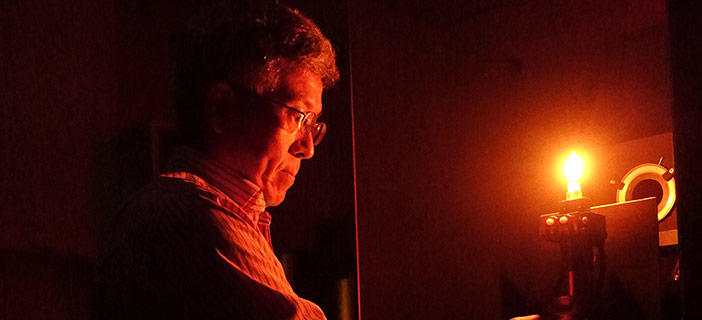Taking Measure
Just a Standard Blog

Here I am with the NIST standard of spectral irradiance. It's not turned up all the way.
As a physicist who explores ways to measure light more accurately, it should come as no surprise that I’m fascinated by even common optical phenomena that we see all around us. For instance, rainbows occur because light travels through water and air at different speeds and because different colors of light travel at different speeds through water. Oil slicks on water, opal and butterfly wings look the way they do because of the way light waves bouncing off of different surfaces or facets interfere with one another.
But while these effects are beautiful, they have practical aspects as well. For instance, the same effect that causes rainbows also allows fiber optic cables to faithfully carry information thousands of miles.
Our understanding of light—and our ability to manipulate it—is helping us to improve our understanding of our world and how we affect it. Much of my own work focuses on ensuring that the instruments on remote sensors, such as satellites that measure Earth’s vegetation cover and land use, are working properly by comparing them against some known quantity or standard, a process called calibration.
My group is also working to improve temperature sensing using techniques based on light. More accurate temperature measurements with a lower margin of error will help climate scientists to make better models of climate change and better evaluate our strategies to address it.
Future technologies will use light-sensing methods. Self-driving cars rely on light-based technologies like radar and light detection and ranging (LIDAR) and get where they need to go using the global positioning system, or GPS. GPS only works because we are able to measure time and the speed of light with incredible accuracy.
In fact, the second itself is defined as the time it takes for specially energized cesium atoms to emit a little more than 9 billion waves of radiation.
Many of the base units in the International System of Units (SI) rely, in one way or another, on different wavelengths of light, from nanometer-long X-rays to kilometers-long radio waves.
The meter is defined as the distance light travels in a little less than one three-hundred millionth of a second. The candela is a measure of the intensity, or brightness, of a specific frequency of green light that most excites the human eye. The mole, used for counting atoms and molecules, is measured using a method called X-ray crystallography, and the practical realization of the ampere, the measure of electric current, relies on microwave irradiation.
The kilogram is the last SI unit based on a physical artifact, a cylinder of platinum and iridium. NIST is in the process of redefining the kilogram using a device called the watt balance. This machine will define the kilogram based on the amount of electromagnetic power it takes to hold a kilogram against the Earth’s gravity. Key to the watt balance is a laser interferometer, a technology that uses the wavelengths of light like the gradations on a ruler to measure distance with great accuracy and precision.
The proposed new definition of the kelvin, the SI unit of temperature, will use acoustic thermometers that measure the ratio between sound and light waves to give us measurements with the highest accuracies.
Light has other physical properties that are yet to be used to realize SI units. Here at NIST, researchers recently theorized it is possible to build “molecules of light.” We used photons to break distance records for quantum teleportation and to prove that “spooky action at a distance” really occurs. I’m excited to see what new innovations the use of quantum effects might bring. Will we one day use them to again redefine the SI units? Will that redefinition open up new technological areas that we have not already envisioned?
If history is any guide, I think they probably will.
So, I just want to say that light is amazing. Light lets us see things that our eyes didn’t evolve to see and study things that further the frontiers of knowledge. The power of light to help us make better measurements, and thus new and better technologies, is truly illuminating.
About the author
Related Posts
Comments
- Reply





